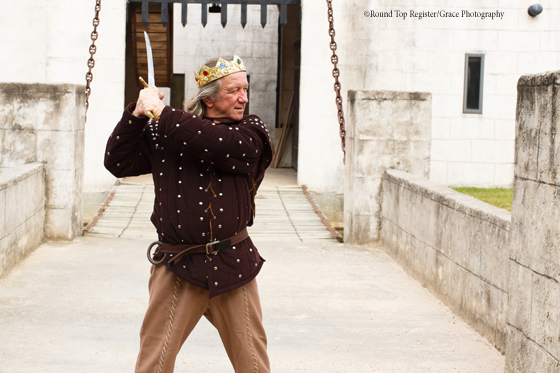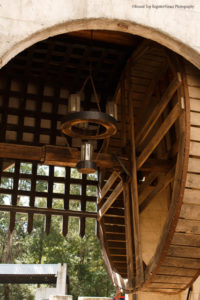A King and His Castle

2024 Spring Antiques Show | March 14 – 31
2024 Fall Antiques Show | October 10 – 27
Mike Newman of Bellville is king of his castle and a child at heart.
“In the mid-‘90s, I purchased 20 acres of land just outside of Bellville with the intention of building a log cabin by hand,” Newman said. “As I was exploring the idea, a neighbor remarked, ‘A man’s home is his castle.’ The thought of a castle captured my imagination.”
Local contractors were not nearly as enamored with the idea.
“Everyone I talked with—and I talked to four or five different people—kept trying to change my plans and make them more conventional,” Newman said. “It became clear that if I were ever going to have the home that expressed my personal vision I would have to build it myself.”
In 1998, after three years of intensive research and analysis, Newman was ready to start building his unusual dream home.
“It took a while to gather the courage to embark on this project,” Newman, who also owns Newman’s Bakery in Bellville, said. “It was a huge, daunting undertaking. Fortunately, I’ve always been mechanically gifted. I assumed that I would figure it out as I went along. You can’t just go buy a drawbridge at Lowe’s.”
While Newman had some professional construction experience, he is a baker by training and trade.
“When I started building the castle, I was getting up at 3 a.m. to make the doughnuts first,” he said. “To say I put in long days is an understatement.”
 In the context of history, a castle is useless if it is indefensible, so Newman turned his attention to that challenge first. Austin County has hills but no mountains. Yaupons and oak trees offered little in the way of defense, but the presence of a pond and a couple of gullies on Newman’s property opened the possibility of a moat. Newman enlisted professionals to help build the moat and pour the castle’s foundation.
In the context of history, a castle is useless if it is indefensible, so Newman turned his attention to that challenge first. Austin County has hills but no mountains. Yaupons and oak trees offered little in the way of defense, but the presence of a pond and a couple of gullies on Newman’s property opened the possibility of a moat. Newman enlisted professionals to help build the moat and pour the castle’s foundation.
“When you build a big house on an island, you don’t want it to sink,” he said.
Newman, along with a single assistant, completed the rest of the construction.
The original plans for the castle, which is built of cinder blocks with masonry stucco, had 3,400 square feet of living space and enclosed a quarter-acre inside its perimeter wall. In addition to a moat and a drawbridge with an accompanying porticullis, the castle features five round corner turrets, a bell tower, a chapel, a great room for celebrations, a courtyard complete with a pell for swordsmanship training, a dungeon (albeit above ground) and a central keep, accessed by a spiral staircase, that provides a dramatic view of the surrounding land.
“I lived in Europe for two years when I was a young man,” Newman said. “And while my time there didn’t directly influence what I built here, it planted seeds and ideas.”
It took eight years to make the castle livable and then two more years of finish work to make it ready for the public. It is still a work in progress. Eventually, Newman plans to add guest rooms to make it even more suitable for special events such as weddings, family reunions and retreats.
“I didn’t set out to build a tourist destination,” Newman said. “I set out to build a one-of-a-kind home, but the entrepreneur in me saw an opportunity to let my home help pay for itself. Entertaining with food is my forte, so this allows me to do that and be lord of the manor.”
My Trip to the Castle
Today, Newman hosts tours of his royal abode six mornings a week year-round by reservation. On the summer day I visited the castle, the group included several families with young children, a four-pack of retirees who were on an RVing expedition, and a field trip for 25 fifth graders from a Houston-area church.
When Newman welcomed his guests, his eyes twinkled as brightly as the jewels in his crown. His sword glinted in the sun. His mannerisms reflected his dual role as local royalty and showman. The court dogs, Avalon, a rangy Irish wolf hound, and Max, a bandana-wearing border collie, flanked him.
While the adults in the crowd got snippets of his attention, Newman concentrated on engaging the children. The years have taught him that parents, grandparents and teachers are quite content to snap photos.
Newman takes his responsibilities seriously. As lord of the manor, Newman introduces new knights, both boys and girls, to the chivalrous code of honor before inducting them into his legions.
On this day, the group collectively agreed to serve their liege, conduct themselves honorably and uphold the law of the land. Then each squire kneeled as Newman touched his sword to their shoulders in an age-old ceremony conferring knighthood. Newman’s page, David Cummings, followed close behind distributing wooden swords to be used in protection of the realm.
Before entering the castle, the lord and his legions moved to the catapult. Unlike most monarchs, Newman built his weapon of destruction himself using 16-foot-long planks. Catapults revolutionized the art of war in the Middle Ages because the devices could throw rocks farther than archers could fire arrows, creating the opportunity for invaders to lay siege to castles.
According to Newman, the largest catapult ever known to exist was used in 1304 against Sterling Castle. The catapult was so large that the people inside the castle wanted to surrender, but the aggressors refused to let them. Newman opined it was because the invaders simply wanted to build a catapult that was 62-feet tall. The first rock it launched was so heavy it knocked down a castle wall.
To demonstrate his own army’s power, Newman and his page readied the catapult. He selected a volunteer to trigger the weapon that sent a rock sailing over and into the moat where it landed with an impressive splash.
The army’s excitement was palpable, but success in battle comes when emotions reach a fevered pitch. Newman encouraged another volunteer, “Dame Katie,” to lead the youthful troops in a rallying cry.
Sadly, the lady was inexperienced and overwhelmed by the opportunity, so the lord stepped in: “Members of the second, we have been together for many years. Living, working and fighting side by side. Today, we will claim victory—side by side. Raise your sword and follow me into this battle. I promise to deliver into your hands the spoils of war—cakes, cookies and pie. Join me in claiming what is ours.”
And, with a rousing cry and swords held high, they were off.
As they thundered across the drawbridge, Newman halted his legion and enlisted three young men to raise the drawbridge. The mechanism resembles a giant, suspended hamster wheel. Raising and lowering the drawbridge requires the “manpower” to climb inside the wheel and pull its top toward the ground while simultaneously walking to put—and keep—the entire wheel in motion.
The youngsters, because of a lack of strength, coordination or teamwork, couldn’t budge the 3,000-pound drawbridge prompting two fathers to take the challenge. With great popping and cracking of the chains and the volunteers’ middle-aged joints, the drawbridge made its ascent.
The amount of energy that spilled into the courtyard is normally confined to a bee hive. Sword-wielding youngsters attacked the pell, a medieval device designed to improve a swordsman’s strength and skills. The shattered remains of battered swords lay like fallen soldiers.
Others tugged on the bell ropes eliciting peals from the four bells, ranging in size from 200 pounds to 1,200 pounds, atop the 62-foot tall bell tower. Still others ran up and down the spiral staircase of the central keep to survey the kingdom from above the tree tops.
A make-believe wedding, officiated by an imitation priest, commenced in the chapel against the tableau created by the rough-hewn altar and religious icons. In the great hall, guests pounded the long, wax-stained tables with their fists and demanded more meat and mead as the host of the pretend feast looked on from the balcony above.
All made their way to the torture chamber, which was outfitted with realistic replicas of an Iron Maiden, stocks and a bed of nails. Horrified giggles escaped its dark confines.
The courtyard fell silent when Newman announced lunch was served in the kitchen. The box lunch feast included sandwiches, chips, fruit and, as promised, plenty of sweets.
As lunch and the tour wound down, Newman took a seat on a long bench by the door. He called the knights before him and asked each of them:
“How have you protected the castle from errant knaves?” (He had to add: “You know the bad guys….” for those knights unfamiliar with errant knaves.)
With each answer, Newman gave the responding knight a piece of “castle gold” for service well-rendered—and bent to tie the shoes of those who weren’t paying attention to such mundane tasks.
When the last guest left, Newman took off his crown and began cleaning up the cookie crumbs and crumpled napkins. Mid-afternoon light streamed into the kitchen, which is equal parts modern convenience and medieval style. He broke the welcomed quiet with an observation.
“There was a fellow from Ohio here today,” Newman said. “When I was a kid, I read a story about a man from Loveland, Ohio who built a castle one stone at a time using rocks he gathered from a neighboring field. That story stayed in the back of my mind. I always thought, ‘If he could do it, so can I.’”
Quest to See the Castle Tours are offered six mornings a week by reservation. To reserve space, call Newman’s Bakery at 979-865-9804 and confirm the number of attendees. On the day of the tour, guests are asked to arrive at the bakery by 10:15 a.m. There you pay for your $15 tickets, which include a box lunch to be served on-site, and receive directions to the castle.
2024 Spring Antiques Show | March 14 – 31
2024 Fall Antiques Show | October 10 – 27